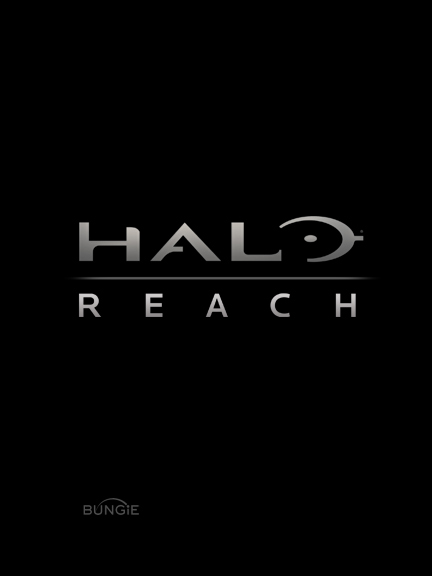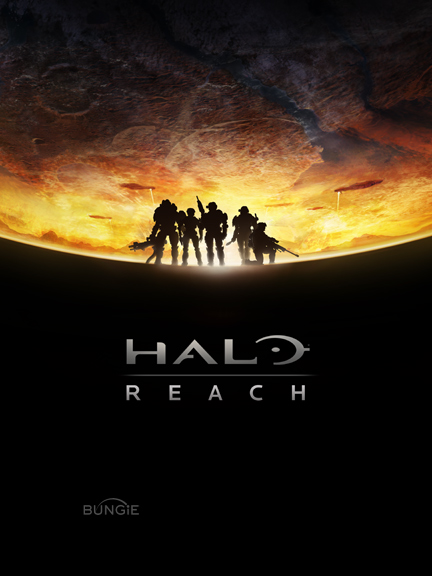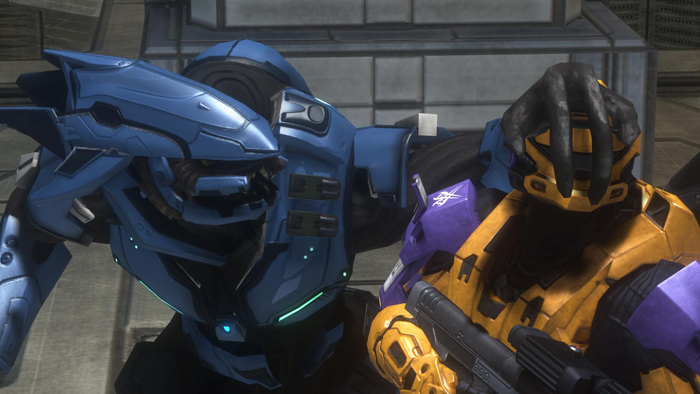Chronique:BWU 16/10/2009
Original[modifier]
Posted by urk at 10/16/2009 3:29 PM PDT
It's been all business around these parts this week with the overwhelming majority of the Bungie collective doing work toward the completion of an important Halo: Reach milestone. Does that mean you're about to get your face filled with a face-filling face full of fulfilling development news? Well, no. But we did coax one illustrious and mellifluous Marty O'Donnell out of the swank safety of his Ivory Tower to chat with us a little bit about recent Reach casting developments.
Though you've come to know our majestic maestro as the man behind Bungie's melodious music, you might not know that he's also heavily involved with the rest of the auditory augmentations that grace our studio's titles. If you hear it, he has a hand in it. He is the Audio Director, after all.
But of course, without a solid audio team and a cast of mighty fine actors and actress, he'd have little to do on the directing front. His supple casting couch would be cold to the touch and the finished product would be sonically frigid. Since he was recently southward soaking up sunshine, finely dining with Buck and Cortana, and politely opening doors for the one and only Rod Stewart, we figured we might as well interview him to get some details on his recent sojourn and give you a look into the process of bringing some life to Halo: Reach's cast of characters.
Marty Goes to Hollywood[modifier]
Marty delivers his own opening line with a plain white binder resting beneath his hands atop the conference room table. The cover conceals the casting sheets and sides that the audio team provided to each actor or actress vying for a role in Bungie's next project, Halo: Reach. When I reach out for the binder to get a look, he tightens his grip. Must be instinct - the information inside the binder is classified.
He loosens his hold and hands over the binder with a smile. One by one, I begin to casually flip through the Reach casting sheets, pretending not to be too interested by the concept artwork and the small snippets of the game's script.
"Those come out of Lee Wilson, the Cinematic Lead on Reach. We've been working on the script for a long time, so we already have a good grasp of the game's characters. This is what their in game model looks like, this is their attitude, and this is the kind of person we're looking for to fill the role - even down to a range of accents that might be interesting to explore."
As I continue to leaf through the pages, Marty continues to point out details about the individual elements that make up each casting sheet.
"So we have stuff like...here's their background, here's where they come from, and we send that over to our casting agencies in LA and Seattle and we get back something like..."
Marty produces a well worn legal notepad. The first page is covered over with handwritten notes. From where I'm sitting it looks illegible, but Marty seems to be able to make sense of it. He explains how the casting process begins as he points to a specific section.
"Here's the first batch of yellow sheets. Our agencies put a call out for actors and come back and say, 'Here are the people we think should read for this.' They recorded them reading what we call sides.
Here's a few lines that are intense, here's a few that are loud, here's a few lines that are romantic...whatever range of emotions we think that particular character has - those representative lines - and after the people read those lines and Jay [Weinland, Audio Lead] organizes everything [laughing], I come in and we go through and listen to the selections."
Q. How many selections are we talking about for the first casting session?
"There were about twenty eight candidates for each role."
Q. Sounds like a mountain of work. How do you break the process down?
"I don't want to know their names; I don't wanna know who they are or where they're from. I don't want to know anything."
Marty flips though the notes he's copied down from the early sessions.
"This one here, number three? X. Means I don't want to hear that person again. It's nothing personal, we make the call simply from what we're listening to, so I make notes like, 'this is a pretty good read, but they sound a little too old' or this person is 'a little too slow or having troubles with pronunciation.' Once we've listened to the tapes, Jay and I compare our notes. We've each had a cold listen without talking to each other and I say, 'Okay what did you think of 12?" and he goes 'Yeah, nah didn't do anything for me," and I say, 'yeah me neither. What do you think of 17?" and he says, 'well, you know, I thought it was a little slow,' and I go, 'Yeah, I thought it was a little slow too, but it was sexy and I like that,' and Jay goes, "yeah, you know it was kinda sexy and I did kinda like that.'
So, this first filter pass gets us to the point where we're ready to get down to maybe five or six actors after starting from about thirty per character."
Q. Do you ever know immediately that someone's just not right for the role?
"A lot of times they start reading and you just go...next! And that's it. I've already heard the first line and I know this person is not gonna make it. They're just not right for the role. But all of these people are actors. None of them are horrible."
Marty laughs a little bit before he offers up a slight revision.
"Mostly. Some are a little over the top. But these are all people who make their living at it in LA and Seattle, so..."
Q. Oh, you pull people in from Seattle to audition too?
"Yeah. The nice thing about our Seattle actors is that most of the time Jay can lay some good groundwork and go through and listen to different Seattle actors' voices and say 'you know, I'm gonna bring these guys in and work with them.'"
Q. Just like that?
"Well, no. We mix them in with all the actors during the cold listen to see how they do."
Q. Oh, okay. Then what?
"Then we come up with five or six for each role, bring Lee in - because it would be horrible for Lee and especially for Marcus to have to go through thirty reads - your ears just burn out and you can't make judgments anymore."
[Ed's Note: Lee Wilson, as already noted, is Halo: Reach's Cinematic Lead. Marcus Lehto is the man at the helm of it all, the Creative Director. Both men are extraordinarily busy making sure every moving part in the well oiled machine that is Bungie stays on track and right on target and they both trust the audio team to make the right decisions. - E.O.]
Marty returns to his notepad, flipping through the curled pages.
"So, for example, here's my stuff with Lee. For each character we ended up with anywhere from one to six people and we eliminated two after talking about it. We wanted to get down to no more than four actors per character for callbacks.
Callbacks are the first time I'm gonna meet most of these people in person. Lee and I made a trip down to LA and this all happened in one day...this thing here."
Back to the notes again. He flips through the notes he jotted down and locates the pages dedicated to the whirlwind LA recording.
"This is the callback session. Everybody's scheduled for five minutes [laughing].
All the actors have to show up at the studio in Hollywood, they come in, they meet us, and immediately they're in the booth and we have them read and I see how they take direction. So a lot of times I'll say - if they're fast - 'now do that again just a little bit slower,' and I'll see if they can go slower. 'Now do that louder or with an accent or make the accent about half of what it is.' I make notes on how well they take direction, how interesting they are to work with, and the general timber of their voice."
"General timber" may sound like an esoteric quality to judge an actor or actress by, but Marty supplies a simple explanation as to why the audio team is interested in the complexities of each performance.
"Sometimes somebody's really good, but they sound too much like somebody you already know you want. At the end of the day, you're trying to get a good ensemble."
He returns to the notepad.
"That was our first callback session and then we narrowed it down again to three people per character and then we get clean recordings of everybody.
Sometimes the initial recordings are done at agent's offices or in a home studio or who knows where, so you get different quality recordings. Jay and I are pretty good at listening to different quality recordings and still judging whether the actor is good, but it's really hard for people who are not used to that to make good judgments. So when we finally play stuff for Lee or CJ [Cowan] or Joe [Staten], I want to make sure that what they're hearing is on an equal playing field.
The weird thing is that when somebody's recording is louder than somebody else's, immediately that's the one that sounds better or they sound more powerful because it's louder, so we equalize everything. Jay levels the volume and makes it all clean, and once again we listen to it blind. Now we're down to three actors per character."
Q. This sounds like it's a pretty long and involved process. Do you ever just zero in on a voice actor or actress right off the top?
"Yeah, there were a couple of people that we were just like, 'wow that person really nailed it,' but we come back up here because one of the problems is the visual effect certain people can have on you in the booth. You see someone who let's say is gorgeous [laughs]. You're like, 'Oh, I love their voice!' and then later on you hear it blind and you're realize that their voice isn't so great. 'Who is that again? Oh, yeah she was beautiful' and you realize that's not the quality you should be making your judgment on for a video game."
Q. Nice. Now you're down to three decidedly average looking people per character (or maybe three people who nailed the audition based on the quality of their readings). What's the next step?
"When you get down to just three, each person has strengths and weaknesses. At this point we bring Marcus in. He's never heard anybody, so it was fun to get his cold feedback right away. It was interesting too because Marcus was almost always choosing our first choice or our second choice as his number one, so we were very close."
Q. Do you think that's born out of having these solid character sheets in hand right from the start?
"Yeah, that's what the character sheet is all about. They're what the team has been talking about — what everybody has agreed on, what the writers have agreed on - and we're all hoping to get a certain type of actor. But, you never know. Sometimes you get a certain actor coming in and they might just bring something to life in a way that you weren't anticipating. You have to be open to that."
The audio team also has to be open to other changes as well.
"When we get down to our top list and suddenly find out we could get everyone but one person because they're out of town shooting a movie, it can affect the entire cast. Maybe that actor paired well with another person and the next option isn't the right choice to fit with the other selections either. Sometimes that causes a domino effect and we have to choose a couple of new people.
But on this latest go around, we had everybody except one guy who's gonna visit the studio on Monday. He's coming up here. He was worth not having at the session at that moment."
[Ed's Note: "The recording light is: ON." - E.O.]
Q. Are you doing any of these recordings in group sessions?
"No. It's all solo work. Everybody has to have the ability to do that and take direction while I'm trying to remember if an actor's already done something that I like. Then it's direction. 'Yeah you need a little more energy or you need to be a little bit faster.' And it's interesting because you're doing things out of sequence. There's no television show or movie that isn't shot out of sequence, so these actors are familiar with the process - that's why they are actors."
Q. How has the Reach casting process been different than it was for ODST?
"We didn't go through this much work on ODST's casting because we were using voices we had already cast for Halo 3 and when we had the three Firefly characters signed up to do it Joe had already started writing the script thinking, 'Oh, this is gonna be Nathan Fillion, this is gonna be Tudyk, that's Baldwin.' It was really kind of fun in that respect. Joe was writing for the kind of characters that those people portray.
For Halo: Reach it's a little different. We're back to square one with a brand new cast of characters and nobody knows exactly who they are. In some ways, we don't even know yet. The actors and actresses we've chosen will get to bring them to life."
Thanks to Marty for sitting down with me for a spell to demystify the casting process. Scorn for the disparaging stuff he whispered into the microphone when I stepped out of the room for a brief minute. Yeah, I heard it on the playback Marty and it hurt. Hurt real bad.
Fight Like a Girl[modifier]
In more urgent news, October means it's time for...
"The Fight Like A Girl Tournament ("F.L.A.G." for short) is an annual Halo 3 Tournament held every October over Xbox Live. The purpose of F.L.A.G. is to raise money for Breast and Cervical Cancer Research. Every dollar donated from the tournament goes towards finding a cure for diseases that affect thousands of women every year. F.L.A.G. is presented by The Cavegirls and is organized by Kari "TheDonWan" and Tasha "Zoom." Please join us this October by donating, playing, or sharing the word about F.L.A.G. Together, we can finish this fight!"
If you already signed up for the tourney or made a donation, thanks for helping out. We'll see you this weekend in the trenches. If you were planning on it and just haven't gotten around to it, registration is over and done with, but you can sure still donate. And you should.
Now.
Glass 'n' Go[modifier]
Our Visual Design team prepped these two Halo: Reach wallpapers for combat insertion. Right click, Save As, and deploy 'em onto your mobile platform of choice. See what I did there with the words and whatnot? Yeah.
Points of Light[modifier]
Lord of databases, Michael Williams, snagged some snapshots of the global Halo 3 player population heatmap for reasons unknown. The images were stored up over a three day span and Stosh took it upon himself to animate it. Not much else to say. I find the slow, rhythmic pulse of the world's waking and slumbering moments somewhat intoxicating. I also find that our massive marketing push into Africa seems to have been met with something less than a smashing success.
Blame Stosh[modifier]
Aside from animating images and working on stuff we can't talk about quite yet, Stosh took some time out to find a screenshot he thought you might like to see in the here and right now. If you don't think it's awesome, you're probably an empty husk of flesh, living out what you can barely call an existence without wont of care or feeling or emotion. A thing - a rotten, putrid, and nauseating monstrosity. And you should blame Stosh. For the image only, of course. All that other stuff is totally on you.
We're Done Here[modifier]
Pack it up. That's all the news I got for you this time out. Don't feel like you have to scurry off straight away though. Make yourself comfortable. Maybe play some matchmaking or a little bit of Firefight. We'll see you next week.






